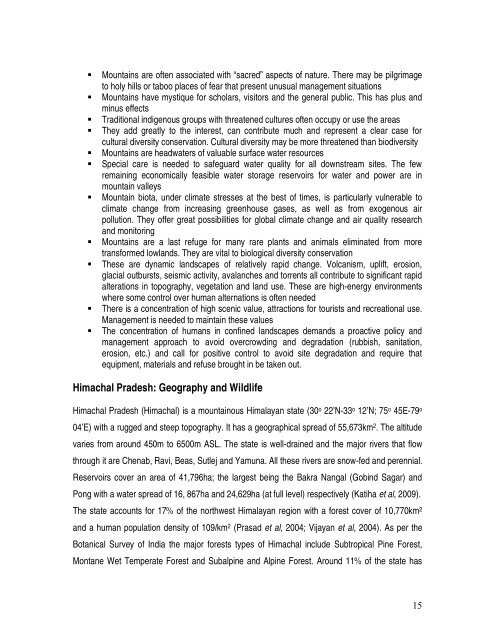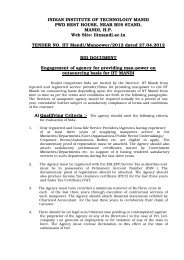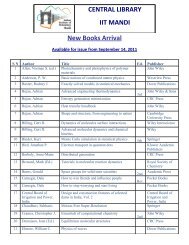Eco Report of the area - IIT Mandi
Eco Report of the area - IIT Mandi
Eco Report of the area - IIT Mandi
Create successful ePaper yourself
Turn your PDF publications into a flip-book with our unique Google optimized e-Paper software.
• Mountains are <strong>of</strong>ten associated with “sacred” aspects <strong>of</strong> nature. There may be pilgrimage<br />
to holy hills or taboo places <strong>of</strong> fear that present unusual management situations<br />
• Mountains have mystique for scholars, visitors and <strong>the</strong> general public. This has plus and<br />
minus effects<br />
• Traditional indigenous groups with threatened cultures <strong>of</strong>ten occupy or use <strong>the</strong> <strong>area</strong>s<br />
• They add greatly to <strong>the</strong> interest, can contribute much and represent a clear case for<br />
cultural diversity conservation. Cultural diversity may be more threatened than biodiversity<br />
• Mountains are headwaters <strong>of</strong> valuable surface water resources<br />
• Special care is needed to safeguard water quality for all downstream sites. The few<br />
remaining economically feasible water storage reservoirs for water and power are in<br />
mountain valleys<br />
• Mountain biota, under climate stresses at <strong>the</strong> best <strong>of</strong> times, is particularly vulnerable to<br />
climate change from increasing greenhouse gases, as well as from exogenous air<br />
pollution. They <strong>of</strong>fer great possibilities for global climate change and air quality research<br />
and monitoring<br />
• Mountains are a last refuge for many rare plants and animals eliminated from more<br />
transformed lowlands. They are vital to biological diversity conservation<br />
• These are dynamic landscapes <strong>of</strong> relatively rapid change. Volcanism, uplift, erosion,<br />
glacial outbursts, seismic activity, avalanches and torrents all contribute to significant rapid<br />
alterations in topography, vegetation and land use. These are high-energy environments<br />
where some control over human alternations is <strong>of</strong>ten needed<br />
• There is a concentration <strong>of</strong> high scenic value, attractions for tourists and recreational use.<br />
Management is needed to maintain <strong>the</strong>se values<br />
• The concentration <strong>of</strong> humans in confined landscapes demands a proactive policy and<br />
management approach to avoid overcrowding and degradation (rubbish, sanitation,<br />
erosion, etc.) and call for positive control to avoid site degradation and require that<br />
equipment, materials and refuse brought in be taken out.<br />
Himachal Pradesh: Geography and Wildlife<br />
Himachal Pradesh (Himachal) is a mountainous Himalayan state (30 o 22’N-33 o 12’N; 75 o 45E-79 o<br />
04’E) with a rugged and steep topography. It has a geographical spread <strong>of</strong> 55,673km 2 . The altitude<br />
varies from around 450m to 6500m ASL. The state is well-drained and <strong>the</strong> major rivers that flow<br />
through it are Chenab, Ravi, Beas, Sutlej and Yamuna. All <strong>the</strong>se rivers are snow-fed and perennial.<br />
Reservoirs cover an <strong>area</strong> <strong>of</strong> 41,796ha; <strong>the</strong> largest being <strong>the</strong> Bakra Nangal (Gobind Sagar) and<br />
Pong with a water spread <strong>of</strong> 16, 867ha and 24,629ha (at full level) respectively (Katiha et al, 2009).<br />
The state accounts for 17% <strong>of</strong> <strong>the</strong> northwest Himalayan region with a forest cover <strong>of</strong> 10,770km 2<br />
and a human population density <strong>of</strong> 109/km 2 (Prasad et al, 2004; Vijayan et al, 2004). As per <strong>the</strong><br />
Botanical Survey <strong>of</strong> India <strong>the</strong> major forests types <strong>of</strong> Himachal include Subtropical Pine Forest,<br />
Montane Wet Temperate Forest and Subalpine and Alpine Forest. Around 11% <strong>of</strong> <strong>the</strong> state has<br />
15
















